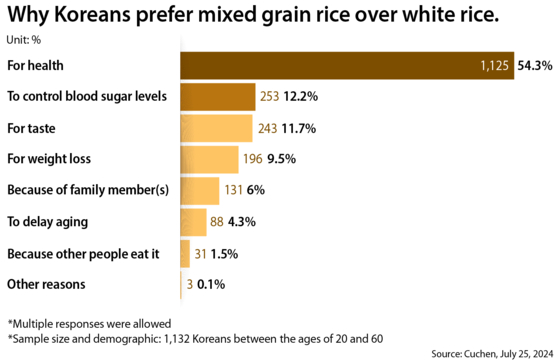It's not black and white: The colorful ways Koreans cook rice
Published: 10 Aug. 2024, 08:00
-

- LEE JIAN
- lee.jian@joongang.co.kr
![Different types of rice eaten in Korean households, often involving beans, peas, barley and black and brown rice [GETTY IMAGES]](https://koreajoongangdaily.joins.com/data/photo/2024/08/10/9f43a549-81ab-4878-a6e8-d596db025fa5.jpg)
Different types of rice eaten in Korean households, often involving beans, peas, barley and black and brown rice [GETTY IMAGES]
Fluffy white mountains of rice have been a sacred culinary mainstay across East Asian dining rooms for centuries. Royals and elites feasted on them while peasants ate other colored grains like barley and buckwheat. White rice is now the prevailing norm and is still prized in cultures across most of the region.
But the tables have turned for the staple grain in 21st-century Korea, where rice with spots of color is preferred over the traditional white. While many restaurants still serve white rice, it is rarely found in home-cooked meals.
Last month’s research from local rice cooker brand Cuchen found that only 24.6 percent of 1,132 surveyed Koreans between the ages 20 and 60 “usually ate plain white rice.” The rest responded that they eat a mix of other grains, vegetables or other foods in the rice.
![Grain and bean varieties that can be seen inside a bowl of rice in Korea [GETTY IMAGES]](https://koreajoongangdaily.joins.com/data/photo/2024/08/10/def9d683-07b2-41b2-9cf2-d32f9e268f4e.jpg)
Grain and bean varieties that can be seen inside a bowl of rice in Korea [GETTY IMAGES]
With its starchy composition and relatively high glycemic index (GI) that can cause blood sugar spikes, wholly milled white rice has earned a particularly bad - even a little unfair - rap as of late.
Ajou University Hospital’s Clinical Nutrition Department said white rice isn’t the ultimate enemy in people’s diets as they have been made out to be these days, though it admits there are better options.
“If you have indigestion, are on a low potassium diet or are weary of consuming too much protein, you should eat white rice instead of mixed grain rice, but otherwise, it is best to eat a mix of white and other grains or beans, and round out meals with animal protein and namul [seasoned greens].”

So what kinds of rice are Korean households eating nowadays? We asked a handful of our newsroom’s Korean members to share their typical workweek rice. From blissfully quick recipes to creative upgrades, here’s what they said.
Herbs and vegetables
Digital desk reporter Kim Dong-eun usually eats white rice or partially milled rice mixed with barley, brown rice and black rice at her home with her family. But from time to time, her mother cooks seasonal vegetables like corn and potatoes whole inside the rice cooker with the rice. This method gets two jobs done at once and the vegetables from the rice cooker are soft and moist. Her family either eats them during the meal or as a separate snack later in the day.
![Sweet potatoes and mushrooms cooked inside a rice cooker with rice [GETTY IMAGES]](https://koreajoongangdaily.joins.com/data/photo/2024/08/10/716bf16d-0271-4b99-a7b9-cc6bd25f878c.jpg)
Sweet potatoes and mushrooms cooked inside a rice cooker with rice [GETTY IMAGES]
Her mother also sometimes throws in sliced eggplant, gondre herbs (Korean thistle) or siraegi (dried radish stems) in the rice cooker. This rice is seasoned tableside with a soy-based sauce. They make for aromatic and healthy rice bowls that don’t call for many banchan (side dishes) other than some kimchi.
Sauce tip: Soy-based sauce for rice in Korea mixes a slight sweetness with spiciness. Some typical additions to the soy sauce include a dash of gochugaru (red pepper flakes) or diced cheongyang pepper (Korean green chili), diced garlic or onions, plum syrup or sugar, sesame oil and sesame seeds, all to taste.
![Siraegi or dried radish stems with rice [GETTY IMAGES]](https://koreajoongangdaily.joins.com/data/photo/2024/08/10/f7899952-06c1-4d77-be19-6881f5229268.jpg)
Siraegi or dried radish stems with rice [GETTY IMAGES]
Packaged grain mixes and instant rice
Graphic designer Lee Jeong-min at the designer desk keeps zero white rice in her pantry. Instead, she buys prepackaged grain mix at the grocery store, which typically includes about a half-dozen different types of grains. Recently, she has been mixing in some kamut, a wheat variety also known as Khorasan wheat with larger kernels. Her mom recommended it as a superfood and another healthy alternative to plain rice. “It has a nice texture and taste, and it isn’t too expensive, actually,” she said.
![Kamut, a wheat variety also known as Khorasan wheat [GETTY IMAGES]](https://koreajoongangdaily.joins.com/data/photo/2024/08/10/633ae255-51e3-438d-9049-915b8840af4d.jpg)
Kamut, a wheat variety also known as Khorasan wheat [GETTY IMAGES]
Lee also keeps a stock of instant rice for evenings when she is too tired to cook. She usually opts for the cheapest options but occasionally seeks out fancier kinds as even instant rice in Korea comes in dozens of varieties. Her favorite is black rice with mushrooms from CJ CheilJedang.
Rice-for-one hack: Lee lives alone so there is always leftover rice. But because it can get stale and smelly when kept in the rice cooker for too long, she makes about five to six portions in a pot over the stovetop and then freezes it. “You just take it out of the freezer, microwave it and it tastes just like fresh rice,” she said.
![Instant rice [JOONGANG ILBO]](https://koreajoongangdaily.joins.com/data/photo/2024/08/10/6d3cbd45-cfc9-4d11-9112-a6b15cb2d533.jpg)
Instant rice [JOONGANG ILBO]
Seafood rice
![Tot, an algae variety, with rice [GETTY IMAGES]](https://koreajoongangdaily.joins.com/data/photo/2024/08/10/02c41552-16bc-4329-a04a-3ab545c0631c.jpg)
Tot, an algae variety, with rice [GETTY IMAGES]
The go-to rice for Executive Editor Choi Ji-young and her husband these days includes tot, an algae variety also known as hijiki in Japan. They make it using dried tot flakes from the supermarket that is simply tossed in the pressure cooker with the rice. It is an easy and time-efficient way of consuming healthy seafood, without having to spend hours soaking the tot in water, according to Choi. It also adds a fun crunchy texture and a slight overall saltiness to the rice. “You can smell some of the ocean,” she said.
In winter, she likes to put fresh seasonal oysters and julienned radish in the rice and cook it in an earthenware pot over the stovetop. It pairs superbly with soy-based sauce with chopped dallae, or wild chives.
![Oysters in rice [GETTY IMAGES]](https://koreajoongangdaily.joins.com/data/photo/2024/08/10/9638bdfb-43f9-47ad-b660-c9f168c14cbd.jpg)
Oysters in rice [GETTY IMAGES]
Whole oats
Culture desk head Yim Seung-hye doesn’t eat rice very often but when she does, she cooks it with whole oats.
High in fiber and calcium, oats are a popular alternative to rice for health-conscious individuals. It usually calls for around three parts oats and seven parts rice or other grains, but Yim opts for oat rice made with 100 percent oats. She cooks it just as she would regular rice inside a rice cooker. She admits it’s really dry, but for those who enjoy the texture of granola, it might be worth a try.
![Kellogg's Whole Oat Rice [JOONGANG ILBO]](https://koreajoongangdaily.joins.com/data/photo/2024/08/10/e015295a-a206-4e35-997b-8b4f06d5e728.jpg)
Kellogg's Whole Oat Rice [JOONGANG ILBO]
Rice fact: Kellogg, the famous cereal brand, launched an instant rice product dubbed Whole Oat Rice in Korea last year, becoming the first cereal brand to debut in Korea’s instant rice sector. It is rice with 100 percent oats and even comes in single, microwave-friendly portions. The product isn’t as mushy as oatmeal but does bear similarities.
Beans, peas and fruits
Beans and peas to Korean children are kind of like broccoli to Americans. Many hate them as kids, stealthily picking them out one by one with their chopsticks when moms aren’t looking and sticking them under their rice bowls. But many also grow to appreciate them.
The JoongAng Daily’s photographer, Park Sang-moon, however, says he’s never been a picky eater. These days, his wife adds black beans in mixed-grain rice. The type of beans or peas changes every couple of months, he said.
![Rice with black beans and barley [GETTY IMAGES]](https://koreajoongangdaily.joins.com/data/photo/2024/08/10/e4724ad6-7ab2-4d46-a77c-fe438c3a3cd7.jpg)
Rice with black beans and barley [GETTY IMAGES]
Some other common varieties inside local rice are green peas, lentils and pat (red beans). Ginko fruits, golden chewy balls with a nutty flavor and slightly funky smell, also make for a popular healthy addition.
Park makes his own breakfast, often involving bread, but for dinners and occasional lunches, he eats with his wife at home. His eldest daughter lives with them, but they don’t eat together too often. “She’s usually eating out or cooking something other than rice at the house,” Park said.
“Young people these days are so attentive to their health and calories, but I’m not a picky eater at all or health-conscious; white or beans, just whatever I get that day is fine. I’ve gotten by fine this far!”
BY LEE JIAN [lee.jian@joongang.co.kr]










with the Korea JoongAng Daily
To write comments, please log in to one of the accounts.
Standards Board Policy (0/250자)